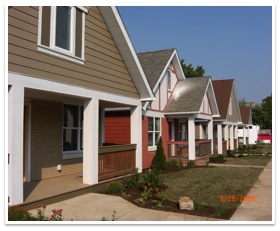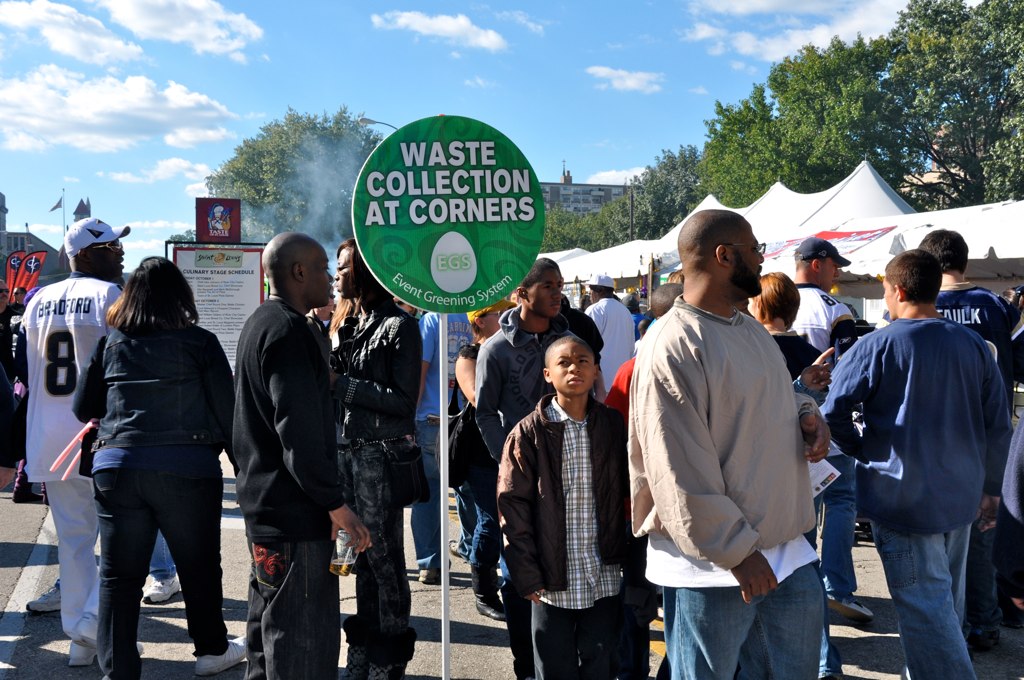Land
Sustainability initiatives relating to land in the City.
The rich natural resources our land provides have been appreciated by flora, fauna and mankind for thousands of years. The confluence of the Missouri and Mississippi rivers allowed Native Americans to build enduring civilizations. The availability of food, resources and water-based transportation also made the Gateway to the West the jumping-off point for early settlers. The City takes pride in caring for this land responsibly and allowing it to support future populations.
Sustainable Development/ Revitalization Efforts
Historic Rehabilitation

- fewer building materials required (thereby conserving natural resources)
- existing infrastructure (sewers, roads and transit) can be used
- less waste sent to the landfill
- a lower carbon footprint for inhabitants due to density
Historic rehabilitation is a more sustainable way of meeting housing demands, and can simultaneously preserve the rich character of a neighborhood. Soulard, Old North St. Louis and Lafayette Square are prime examples of the benefits historic rehabs can provide for a community.
St. Louis' revitalization efforts have turned vacant buildings into economic and cultural assets that fuel further development, improve quality of life and have reversed decades of decline. St. Louis won the World Leadership Award in 2006 in recognition of these successes.
Revitalization of Vacant Properties & Brownfields
The City is currently saddled with about 10,000 parcels of vacant land that have come to public ownership involuntarily through tax foreclosure. To generate innovative sustainability uses of vacant land -- whether in public or private ownership -- the City is partnering with Washington University in St. Louis to conduct a Sustainable Land Lab Competition. Information is available on the website: http://sustainablecities.wustl.edu/land-labs-competition/
In addition, many of the City's vacant property consist of Brownfields -- abandoned industrial or commercial facilities available for re-use. However, redevelopment is often complicated by fear of environmental contamination. St. Louis Development Corporation uses a variety of grants and in-kind services to identify, test, and clean up Brownfields throughout the City. Once the true nature and extent of contamination is known, Brownfield properties often have much lower levels of contamination than expected, and safe and cost-effective remediation can be accomplished through traditional cleanup approaches and/or risk-based corrective action. Redevelopment of Brownfields improves public health and the environment. It eliminates blight in plants, improving community image and long-term sustainability. It also discourages urban sprawl by utilizing existing public infrastructure. Downtown St. Louis and Washington Avenue are home to several redeveloped Brownfields. Notable accomplishments include soil cleanup in support of Habitat for Humanity's construction of LEED certified homes, underground tank removal and technical assistance facilitation in support of the Bee Sweet Orchard, and assessment, underground tank removal and cleanup supporting creation of a school garden.
Green Ordinances & Sustainable Growth
 Building rehabilitations have helped St. Louis grow sustainably, especially when properties are retrofitted to meet green building standards, such as those identified in the Leadership in Energy and Environmental Design (LEED) rating system. Indeed, St. Louis has one of the highest levels of LEED-certified buildings in the country. This level is constantly increasing as Habitat for Humanity is working hard to create green affordable neighborhoods. Habitat is expected to build 100 LEED Platinum homes in St. Louis City.
Building rehabilitations have helped St. Louis grow sustainably, especially when properties are retrofitted to meet green building standards, such as those identified in the Leadership in Energy and Environmental Design (LEED) rating system. Indeed, St. Louis has one of the highest levels of LEED-certified buildings in the country. This level is constantly increasing as Habitat for Humanity is working hard to create green affordable neighborhoods. Habitat is expected to build 100 LEED Platinum homes in St. Louis City.
The City of St. Louis government has made a commitment to sustainable building through several "green" ordinances.
Ordinance 67803 requires that builders analyze energy consumption, long-term operating costs and possible energy efficient measures for all new municipal construction or major remodels of municipal buildings.
Ordinance 67414 directs the Board of Public Service to adopt the LEED green building rating system for all newly constructed and renovated city-owned facilities, with projects complying with the LEED Silver standard to the extent possible.
Due to these two ordinances, future municipal buildings will require less energy to operate, save the City money and reduce greenhouse gas emissions from energy production.
Parks & Urban Forestry
St. Louis has 3,000 acres of park land divided into 111 beautiful City parks. These open spaces help anchor neighborhoods and improve quality of life. Furthermore, many of these parks are heavily forested, and the trees provide benefits such as carbon sequestration, reduced noise pollution, air quality improvement and soil erosion prevention. Studies have shown that trees help promote relaxation and well-being and contribute to decreased incidence of domestic violence and child abuse.
In recognition of the many benefits that urban trees provide, St. Louis City Ordinance 68607 states that the City shall have no net loss in the population and canopy of its urban forest. Furthermore, all reasonable steps should be taken to prevent destruction of or damage to City trees (other than those approved for removal) during building construction or demolition.
Learn more about how the City is working to enhance, expand and improve its greenspace and natural resources through the City of St. Louis Urban Vitality & Ecology Initiative.

St. Louis was first designated a Tree City USA (TCUSA) in 1981. The City was named a Sterling TCUSA in 2005 after having received 10 Growth Awards from the Arbor Day Foundation. St. Louis was the first city in Missouri to earn this honor, and has since received four more Growth Awards in recognition the Forestry Division's continual improvement and innovation.
The Forestry Division works proactively to care for the many thousands of trees in the St. Louis area, and plants 4,500 new trees annually. More than 74,000 trees line City streets and provide the additional benefits of air pollutant removal, increased property value and lower home energy use (trees shade homes during the summer and keep them cooler). A street tree resource analysis found that the trees provide a net annual benefit of $913,660 for the City of St. Louis. The Forestry Division follows a no-net-loss policy, planting a new street tree for each that is removed, and also plants street trees at no charge to adjoining property owners (request by calling 314-613-7200). The Forestry Division also composts all wood & leaf waste and operates a Christmas tree recycling program that composts 16,000 trees a year.
The Forestry Division provides information about the effects of the invasive Emerald Ash Borer in St. Louis, and has active policies for the treatment, removal, and replanting of affected trees.
Forest Park, located in the middle of the City, is the jewel of city parks with 1,293 beautiful acres-- almost 500 acres more than New York's Central Park. The park offers fabulous cultural and recreational opportunities and provides habitat for wildlife.
Citygarden, St. Louis' new downtown sculpture park, is an urban oasis among the skyscrapers, with many native trees and plants. Opened in July 2009, Citygarden is a dramatic new addition to the City's civic and artistic fabric. The innovative urban oasis delights and educates residents, workers and visitors of all ages, particularly with young children, with minimal environmental impact: rain gardens, green roofs and native plants flourish, and a locally-sourced cafe contributes to Citygarden's sustainability.
Learn more about Sustainability and City Garden
Urban Agriculture
Urban Agriculture - Best Practices and Possibilities - This report provides an overview of urban agriculture and local food system resources and practices across the United States and parts of Canada, with a primary emphasis on providing resources that can encourage and support urban agriculture in Missouri’s metropolitan areas.
Materials Management
Residential Recycling
Recycling is another major component of St. Louis' sustainability goals. Recycling saves money and energy, conserves natural resources, reduces pollution and benefits the local economy. Almost 16,000 people are employed in 1,500 local recycling businesses in the St. Louis Metropolitan Area. The City provides single-stream recycling services to residents.
The City also encourages recycling and composting at special events and celebrations.

Learn more about St. Louis' recycling program
Environmentally-Preferable Purchasing
Consumers have the opportunity to "vote with their pocketbook" by choosing environmentally-friendly products that are reusable, recyclable or made without chemicals that can harm people or the environment. Each individual product provides a small environmental benefit. However, when purchases are viewed cumulatively, over the course of a year or a lifetime, small benefits really add up. And when companies, governments or businesses change the products they buy, the effects can be even greater.
Find more information about environmentally-preferable products
Where economically feasible, the City's Supply Division considers environmentally-preferable products, as requested and on a case-by-case basis. An example of a "green" City purchase is ordering paper with 30% post-consumer content.